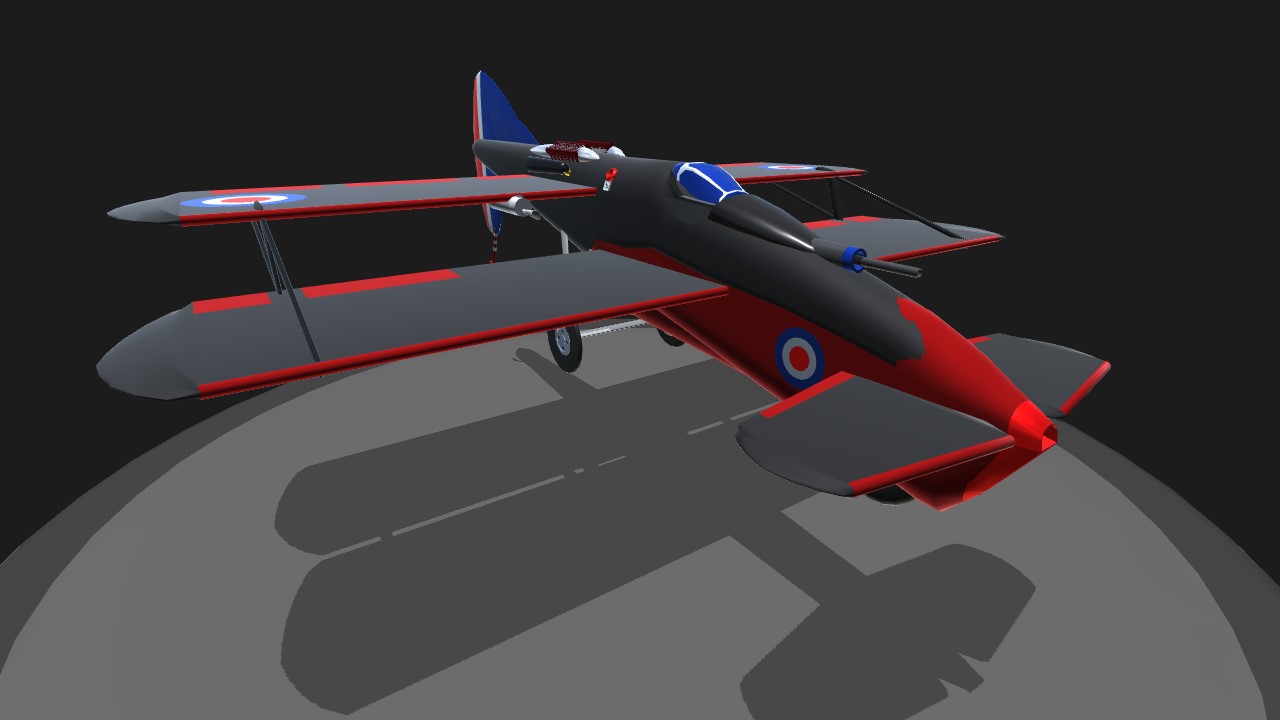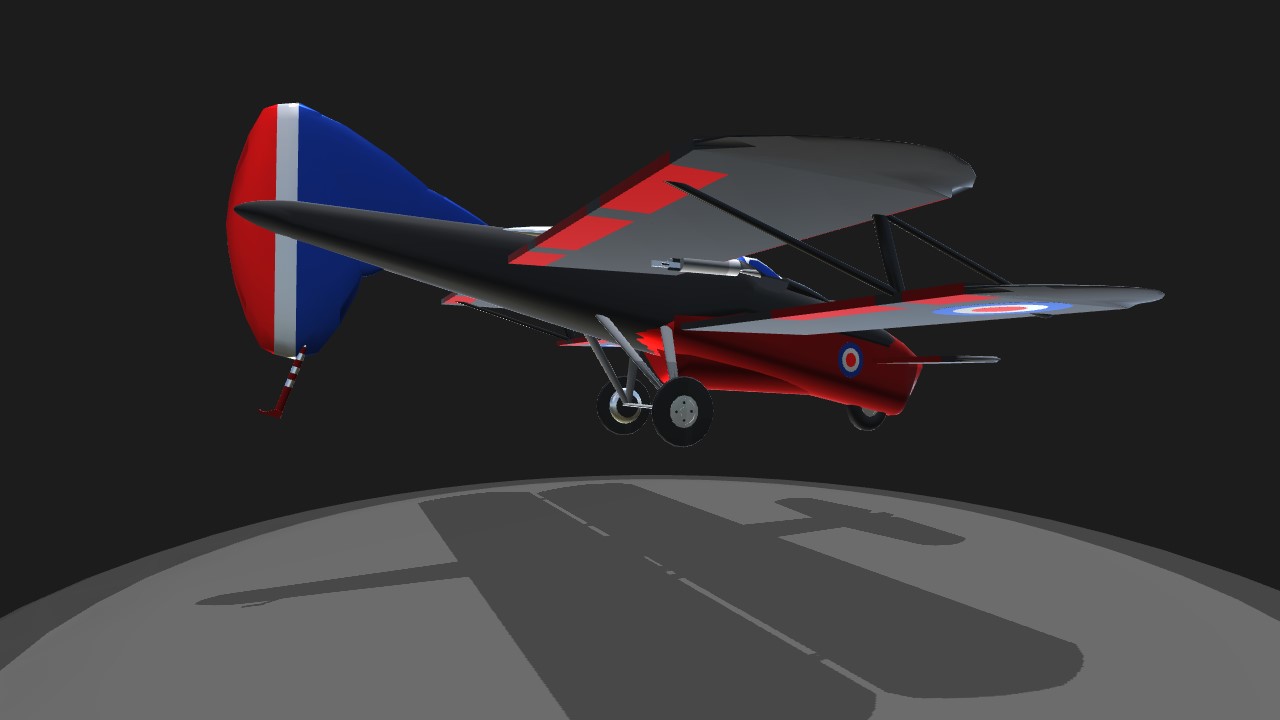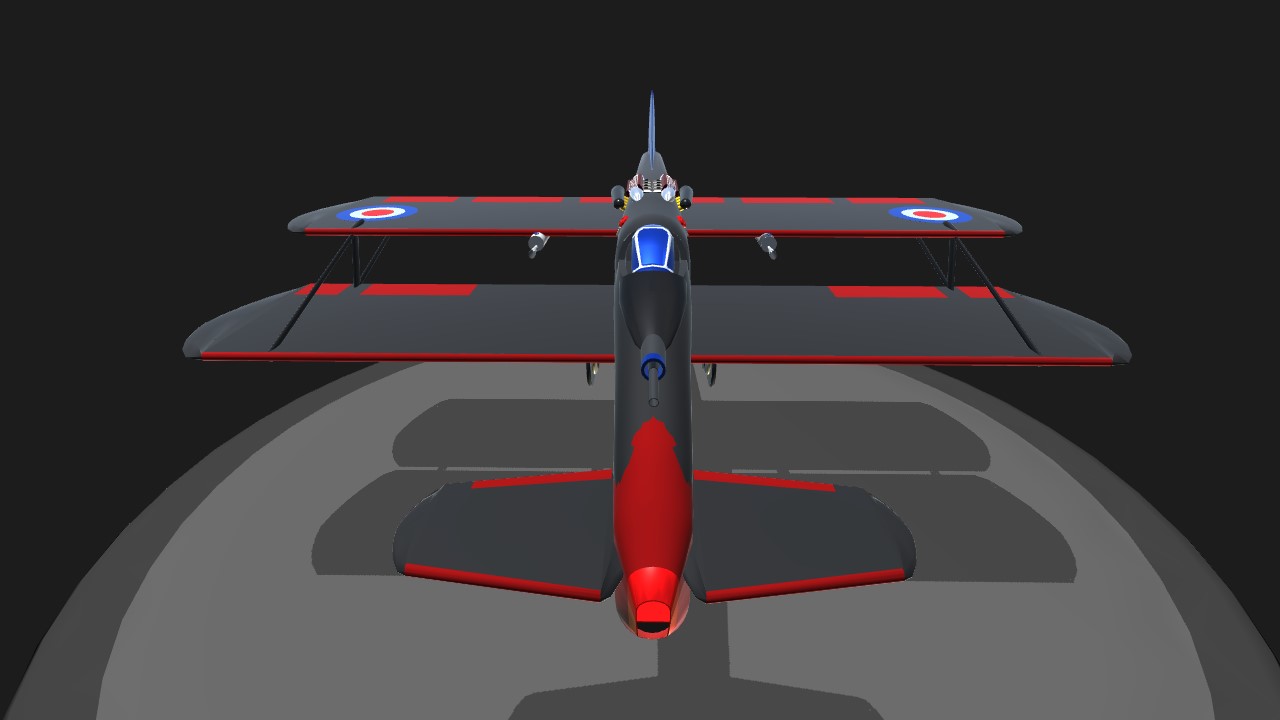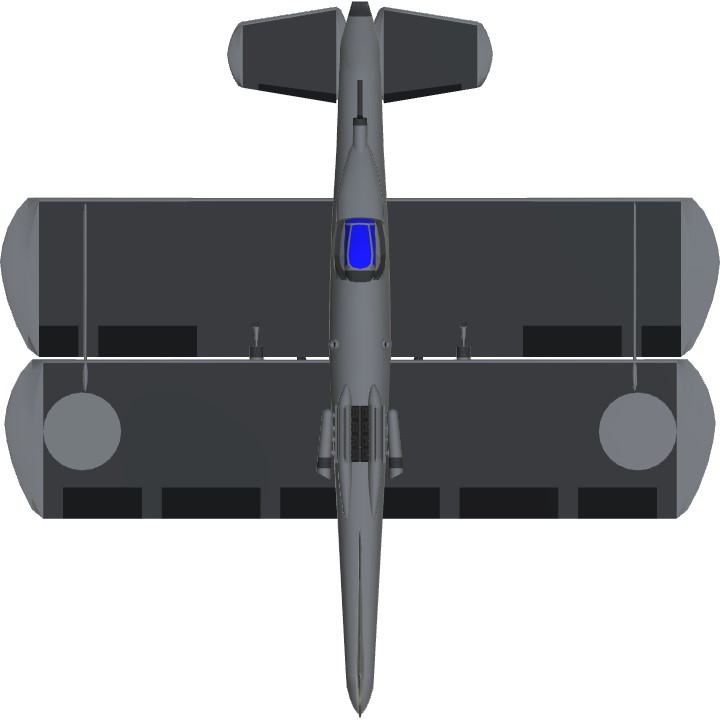VERY VERY LOUD ENGINE WARNING!!
Please turn down your volume (or zoom out in Orbit/Chase cam) before flying, especially if you use headphones!
This is going to be the first of many "Experimental Concepts" based around de Bruyere's original C1 airplane (which I already built). However, this is the only other one that will even come close to being within the rules for the WWI Challenge... but even still, I expect it to get DQed. :P NEVERTHELESS! On to the backstory and details!
The Idea...
This variant runs with the idea that de Bruyere succeeded with the C1 and/or didn't abandon the design entirely after that failure. Using that mindset, this build -- and others I plan that will be part of a "What If" series -- is dubbed 'xC' to keep with the original's naming, but also to set it apart slightly.
The fuselage and its unique design is going to be what remains mostly unchanged between everything. The initial focus on the xC.2 was to try and make it a little more stable in the air. Inevitably this resulted in the curious Biplane wing arrangement that you see here, which helped but did not solve things entirely.
Next Up: Propulsion...
The Pusher propeller actually seemed to be the biggest cause of instability, so it had to go. Unfortunately, there really wasn't anywhere else to affix something on account of the fuselage design, but I found that an under-slung jet engine placed right infront of the rear wheels had pretty much solved all of the problems that were left!
An Unconventional Solution...
New problem... It's a "Jet Engine", and this is WWI-era.
What I settled on was something very unconventional, but probably non-functional in the real world -- or too modern at least: an internal combustion engine driven jet engine. There were such beasts, but different in too many ways, nevermind coming many years later. Therefore I abandoned the 'jet' concept almost entirely, settling on still using the V8 of the C1 but having it remotely powering 4 sub-sized Propeller Hubs.
EDIT: [...a few days later...] I've actually come to discover that the "I.C.E.-driven jet engine" concept -- known as a Motorjet -- was actually NOT developed years after WWI, as I had originally thought! As it so happens, a very close precursor to this was made in 1910 by Coanda. However, I won't be modifying the xC.2-DP, so this is just a side-note.
The "Ducted Propeller(s)"...
Ducting wouldn't be too far 'out there' in terms of a concept, but I had to be careful how I implemented it. This is why I'm fearful it won't be a valid entrant, but I was too far along to abandon it!
These are very-VERY low powered, in keeping with the idea that ALL of them are being driven by a single V8. Therefore, the combined total is what equals that of the V8... And wouldn't you know? The damn thing worked!! 4 tiny propellers inside the bottom of the fuselage, contained in what (with imagination) is a ducted cavity with fore and aft openings, manages to produce enough propulsion (thrust?) to allow the xC.2-DP to fly!
A Small Caveat... Or two...
It flies with 4, though each has 8 blades and quite a considerable chord value. Yet I figured given their size compared to a giant propeller that the C1 used, it wouldn't necessarily be implausible. Their small size means they could technically be made from a single piece of wood, which could indeed be more sturdy than a blade made from multiple pieces. Their smaller size also means the tips of the blades are not spinning as fast as a large diameter blade does.
The other caveat being that, I opted to use 5 hubs instead of 4, only because it was slightly more friendly to fly. To compensate that small 'fudging', I limited that 5th hub to roughly 2/5ths the max RPM that the others spin. This gives the xC.2 a bit more oomph down the runway, but only minor benefit when in the air. Furthermore, the extra engine increases the fuel consumption, which I liked. as I felt that made it more realistic for flying time.
A Minor Concession...
There's the small fact that the grand total of power output from the 5 propellers exceeds the 150HP the C1's V8 produced, and with the 5th it exceeded the 200HP I was willing to say might be possible to squeeze from it. So with that I propose that the fact it does, can be attributed to a multiplier gear-drive, much like what modern Kit Planes use if you want to employ a standard car engine (since they can't rev high enough). Since it's a combined 250HP is all, I didn't think it was unreasonable. :D
--== DETAILS ==--
- Fully actuated Canard
- Mid Engine (250HP) powered Ducted Propeller (DP) Unit: 5x 8-bladed propellers
- Tricycle Gear + Rear Skid
- Prototype Cockpit Canopy
- 1x TRP 37mm Auto-Canon; 200x HE Ammo (Multirole)
- 2x Upper-wing Mounted "Tir Rapide" M1917 belt-fed Machineguns (water-cooled) (Fast Firing)
--== CONTROLS and SPEEDS ==--
- AG1 to toggle the Canon (so you can move the camera and not waste ammo!)
- Ideal Takeoff Speed: 110MPH | Easy
- Short Takeoff Speed: 80MPH | Difficult
- Cruise Speed: 140MPH @ 100% Throttle
- Max Speed: 2° nose-down 155MPH; > 30° nose-down (diving) 200+MPH
- Max Altitude: UNDETERMINED
- Landing Speed: Any!
- Landing Distance: Twice the plane's length (seriously, it stops on a dime! lol)
- Stall Speed: Around 50MPH
- Problems Controlling Speed: Below 50MPH
- Fuel Time: Roughly 20 minutes.
--== TAKEOFF and LANDING ==--
LAZY Takeoff (Wright Airfield):
- Full Throttle
- Let it run off the end of the runway, and off the end of the island, where it will have enough speed to do its own thing.
- It will level itself off and continue flying until it runs out of fuel. (Albeit with an even-slright right auto-yaw, and even more slight auto-roll)
NORMAL Takeoff:
- Full Throttle
- Gently Pitch Up around 100MPH, just enough to get the nose up.
- Gently climb to desired altitude.
Landing:
- Throttle %: Any!
- Glide in until wheels are on the ground
- Mash the Brakes
--- NOTE: It can easily land on roughly 1/8th the length of USS Tiny
--- NOTE: It's super easy to land this bird that there's not much reason to even give this tutorial.
-= TEST PILOT FEEDBACK =-
- "Stall" behavior is... very interesting. At low angle-of-attacks (sub-30deg), it sort of just hangs there in air (at full-throttle).
'' I am a leaf on the wind, watch how I soar'' - Hoban 'Wash' Washburne, "Serenity"
- Like the C1, still slightly 'squirrely', but now only during extreme maneuvers; far far easier to fly overall.
- Rolls are laborious and put the nose into a slight dive as the wings level out, for... reasons I'm not really sure of.
- Rolls get less laborious the higher your airspeed. (This will be much more fun to fly as a jet!)
- Yaw... is still worthless, but does not produce the fish-wobbles like the C1 (at least, not as bad)
- The Tricycle landing gear is robust! Don't be afraid to come in a bit hard for a landing.
- Since I used the Landing Hook for aircraft carrier landings as the "Tail Skid", it too is extremely robust and you won't have to worry about it breaking; I never managed to. (This is also why I didn't add the additional support braces like the one in real life had back there.)
FINAL NOTE: The "Rockets" in your 'Ground to Air' menu are permanently disabled (I hope!). Those rockets are being used as "bullets" in the wing machinegun's ammo belt.
Enjoy!
Specifications
General Characteristics
- Predecessor WWI Challenge [CLOSED]
- Successors 1 airplane(s) +14 bonus
- Created On Windows
- Wingspan 37.9ft (11.6m)
- Length 37.7ft (11.5m)
- Height 14.3ft (4.4m)
- Empty Weight 3,449lbs (1,564kg)
- Loaded Weight 4,451lbs (2,019kg)
Performance
- Horse Power/Weight Ratio 0.056
- Wing Loading 7.7lbs/ft2 (37.8kg/m2)
- Wing Area 575.2ft2 (53.4m2)
- Drag Points 1176
Parts
- Number of Parts 197
- Control Surfaces 12
- Performance Cost 1,058







RATING
Looks : 6/10 pts.
Performance : 8.65/10 pts.
Details : 6/10 pts.
Weaponry : 8.5/10 pts.
OVERALL RATING : 7.28/10
@Flewey Naw, it's definitely something that I can admit has become a labor of love... :}
I just feel like there is/was potential in that absurd C1 design, but just as well after finishing that bird, I saw all these various ways I wanted to transform it into something more modernized.
.
I have no clue how they will eventually turn out, if they'll be good planes or equally plagued with issues needing ironing out -- cursed, as you put it lol.
But thankfully I have the ability to pull on the strings that govern the physics in the universe of SimplePlanes, so if there's a will -- and clearly I have one -- then there's definitely a way to get such a best like this to be functional! :D
.
Truth be told, I'm almost certain that some of the issue with how it performs, at least in SP, is the lack of any real details on the C1 [CoM for example], but also the horribly underpowered propulsion system. At one point on the C1 I gave its prop way more power, and it took out a lot of the cursed issues with it. Similarly, once i gave this design a jet (in that under-slung pod), it was phenomenal... Alas, such a powerful jet was outside the scope of the challenge, so I had to drastically detune it.
... It's the builds I have in mind that are beyond this WWI Challenge that are going to be of interest for me, and what I'm really looking forward to playing with! ^_^
@Formula350 To answer your inquiry, I was amazed at how something so cursed and flawed in the first place could become even more so cursed. Although, to clarify, I do not want to belittle your crafting skills, and therefore I applaud you in that area…
@MAHADI
...pulls hands away from keyboard...Yessir :} lol
@STDeath Thanks, I'm glad you enjoyed both!
And I agree, the hindsight we are afforded thanks to human history being documented, plus our natural creativity, opens so many doors to curious and interesting new things... even if it IS purely fiction :D
It’s aviation fiction that is interactive, I love it. It was fun to fly and the story was entertaining. 👍
@Formula350 alright alright. STOP TYPING!
@Flewey ROFL
I take great pride in that response, thank you! :D
.
Alhough, I'm not 100% sure what it's exactly in response to...
Whether it's to this build, or my claim to allow "crude jets" in WWI planes, or specifically my example about a "conventional engine that drives a shaft with turbine blades".... :P
If by chance it's that last one, I couldn't remember what it was called in the moment but it's a "Motorjet" lol
Which actually is even MORE fuel to my claim, since it indicates dates of 1908 and 1917... and, even more perfect: France! (It was that 1930 Caproni Campini N.1 that was where I first learned of such an engine combo)
...
[inhales]
Uh..
Wat
2/2
In conclusion, it seems that a low-power Turbine concept (crude 'jet') is actually inside the timeframe of the era. Therefore, something such as a conventional gas engine that drives a shaft with turbine blades where additional fuel is injected for added thrust, or a primitive sort of turbo-prop configuration, would be plausible and valid methods of propulsion for a Fictional WWI-era vehicle... :D
(at least that's my two cents worth)
@MAHADI I'm just going to bring this up here and run it by you.... Even though it technically doesn't help this build while using propellers, I'd be able to submit a 'fix' for it!
I believe I've found legitimate evidence that opens up Internal Combustion Turbine engines for use in WWI-era vehicles... O_O
Hans Holzwarth 1905 patent# US783434A for a "Rotary Combustion Engine".
(I've only made small grammatical corrections to this digitization's auto-transcription of the original text, where some words were not spaced apart; also a single 'typo'.)
My invention relates to internal-combustion engines..
The object of my invention is to provide means for the practical application of the direct force
developed by combustion in the operation of a turbine. In an ordinary turbine no means are
provided for compressing combustible gases nor for confining such gases during ignition
even though a preliminary compression were provided for.
.
My invention therefore contemplates the provision of separate expansible combustion
chambers in which a compression may be secured (at least a final compression)
and which will offer sufficient resistance to the initial pressure of the burning gases to
produce a complete ignition and then deliver the gases into the turbine in a manner to
develop the highest efficiency.
.
My invention also contemplates utilizing the force expended in expanding one
combustion-chamber to produce a final compression in another similar chamber, the
arrangement being such that a four-cycle movement is secured by successive ignitions in a
set of four chambers without reference to the movement of the turbine and entirely
independent thereof.
Furthermore, in 1910, a (seemingly different) Holzwarth's design managed 200HP (150kW):
1910: Holzwarth impulse turbine (pulse combustion) achieved 150 kW (200 hp)..
Almost more notable is that in 1903, another inventor managed to achieve an output that was greater than the input requirement to run the turbine:
1903: A Norwegian, Ægidius Elling, built the first gas turbine that was able to produce morepower than needed to run its own components, which was considered an achievement
in a time when knowledge about aerodynamics was limited. Using rotary compressors
and turbines it produced 11 hp.
Both of these quotes came from: [https://en.wikipedia.org/wiki/Gas_turbine](https://en.wikipedia.org/wiki/Gas
@Formula350 that's not real. this might get disqualified.
@MAHADI lol All 5 of them are inside the fuselage, in that bottom protrusion spanning from the rear wheels to the front Inlets.
xC.2-DP = Ducted Propellers :}
where is the propeller?
Aaand now my fingers hurt from all that typing!
@MAHADI My second "entry" for the WWI Challenge. It is
notjet powered, but, I'll also understand if you feel it is not valid.I made this purely for the fun and joy of making it, being quite pleased with the end result either way! :)